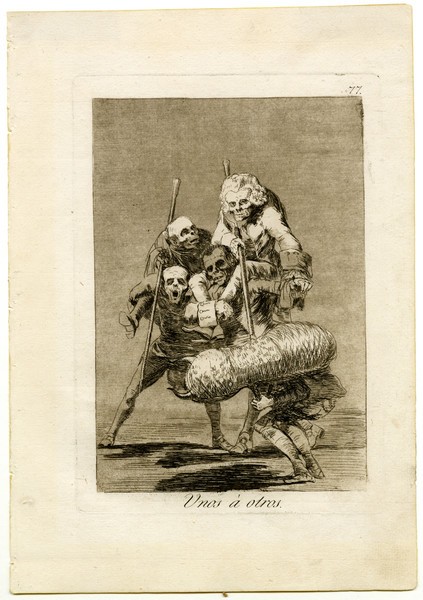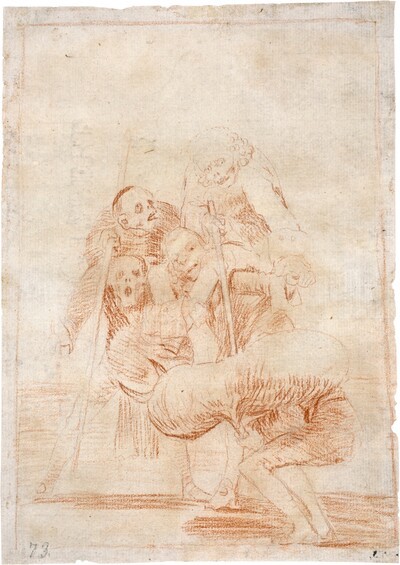- Cronología
- Ca. 1797 - 1799
- Dimensiones
- 218 x 152 mm
- Técnica y soporte
- Aguafuerte, aguatinta bruñida, punta seca y buril
- Reconocimiento de la autoría de Goya
- Undisputed work
- Ficha: realización/revisión
- 13 Jan 2011 / 29 May 2024
- Inventario
- 225
Unos á otros. (at the bottom)
77. (in the upper right-hand corner)
See Francisco de Goya y Lucientes, Painter.
There is only one state proof with burnished aquatint, except for the upper part of the spears, dry point and prior to the burin in the Amsterdam Rijksmuseum. The title has been handwritten on it, in which one can read Casa rara, pero ay mas, crossed out and under which the definitive title has been written.
A preparatory drawing for this print is in the Prado Museum.
Two characters ride on the shoulders of two others as if they were their horses. They take turns to place a pike on a wicker bull, which is held by a figure with his back to the viewer. The man on the left side of the engraving looks like a monk dressed in a habit and is mounted on an abbé wearing black clothes and buckled shoes. The other pair is composed of two noblemen, judging by their wigs and rich clothing with elegant, wide-cuffed jackets and buckled shoes. The latter are clearly reminiscent of those in Dream 16: Growing Up After Dying.
The Aragonese painter has distorted the features of the figures. The faces are cadaverous and emaciated, the eye sockets are strongly sunken and the bones of the faces are decisively marked. Through this monstrous physical appearance, it is possible that the artist is also trying to characterise them from a moral point of view.
In this engraving, Goya uses fine-grained aquatint in which the whites, achieved with the varnish reserves, and the soft burnishing of the men and the bull give a highly dramatic effect. He also uses the burin to finish off the ends of the spears.
The Prado manuscript describes this print as follows: "Thus goes the world, one mocks and bullfights another: he who used to be a bull now plays the knight in the bullring. Fortune directs the party and distributes the roles, according to the inconstancy of her whims". However, the one in the National Library comments: "The old fogies (Voltaire and Piron) are still fighting each other".
In this engraving Goya attacks the old social structure in which the nobility and the Church exploit the ignorant people, in the same way as he does in Caprice No. 42, You Who Cannot.
It is possible, as in other engravings in the series, that this image has more than one meaning and that, according to the manuscript in the National Library, Goya is referring to Voltaire (Paris, 1694-1778) and Alexis Piron (Dijon, 1689-Paris, 1773), between whom there was a rivalry that went beyond the literary.
The plate is in rather poor condition is preserved in (National Chalcography, no. 248).
-
Goya. Gemälde Zeichnungen. Graphik. TapisserienKunsthalle BaselBasle1953from January 23th to April 12th 1953cat. 255
-
Goya y el espíritu de la IlustraciónMuseo Nacional del PradoMadrid1988from October 6th to December 18th 1988. Exhibited also at Museum of Fine Arts, Boston, January 18th to March 26th 1989; The Metropolitan Museum of Art, Nueva York, May 9th to July 16th 1989, Madrid curator Manuela B. Mena Marqués, scientific directors Alfonso E. Pérez Sánchez and Eleanor A. Sayrecat. 62
-
Goya. La década de Los CaprichosMadrid1992organized by Real Academia de Bellas Artes de San Fernando sponsored by Fundación Central Hispano, Madrid, consultant editor Nigel Glendinnig. From October 26th 1992 to January 10th 1993cat. 174
-
Francisco de GoyaMuseo d'Arte ModernaLugano1996exhibition celebrated from September 22nd to November 17th.cat. 77, p.104
-
Francisco Goya. Sein leben im spiegel der graphik. Fuendetodos 1746-1828 Bordeaux. 1746-1996Galerie KornfeldBern1996from November 21st 1996 to January 1997cat. 83
-
Goya e la tradizione italianaFondazione Magnani RoccaMamiano di Traversetolo (Parma)2006consultant editors Fred Licht and Simona Tosini Pizzetti. From September 9th to December 3th 2006cat. 77, p. 165
-
Goya. Opera graficaPinacoteca del Castello di San GiorgioLegnano2006exhibition celebrated from December 16th 2006 to April 1st 2007cat. 44
-
Goya e ItaliaMuseo de ZaragozaZaragoza2008organized by the Fundación Goya en Aragóna, consultant editor Joan Sureda Pons. From June 1st to September 15th 2008cat. 347
-
Goya et la modernitéPinacothèque de ParisParís2013from October 11st 2013 to March 16th 2014cat. 176
-
Goya: Order and disorderMuseum of Fine ArtsBoston2014cat. 234
-
Goya engravings and lithographs, vol. I y II.OxfordBruno Cassirer1964p.155, cat. 112
-
Vie et ouvre de Francisco de GoyaParísOffice du livre1970p.185, cat. 607
-
Goya, la década de los caprichos: dibujos y aguafuertesMadridReal Academia de Bellas Artes de San Fernando1992pp.285-287, cat. 174-175
-
Catálogo de las estampas de Goya en la Biblioteca NacionalMadridMinisterio de Educación y Cultura, Biblioteca Nacional1996p.115, cat. 169
-
El libro de los caprichos: dos siglos de interpretaciones (1799-1999). Catálogo de los dibujos, pruebas de estado, láminas de cobre y estampas de la primera ediciónMadridMuseo Nacional del Prado1999pp.380-383
-
ParísPinacoteca de París2013p. 241
-
Goya: Order & DisorderBostonMuseum of Fine Arts Boston Publications2014pp. 336-337
-
Goya. In the Norton Simon MuseumPasadenaNorton Simon Museum2016pp. 42-75

